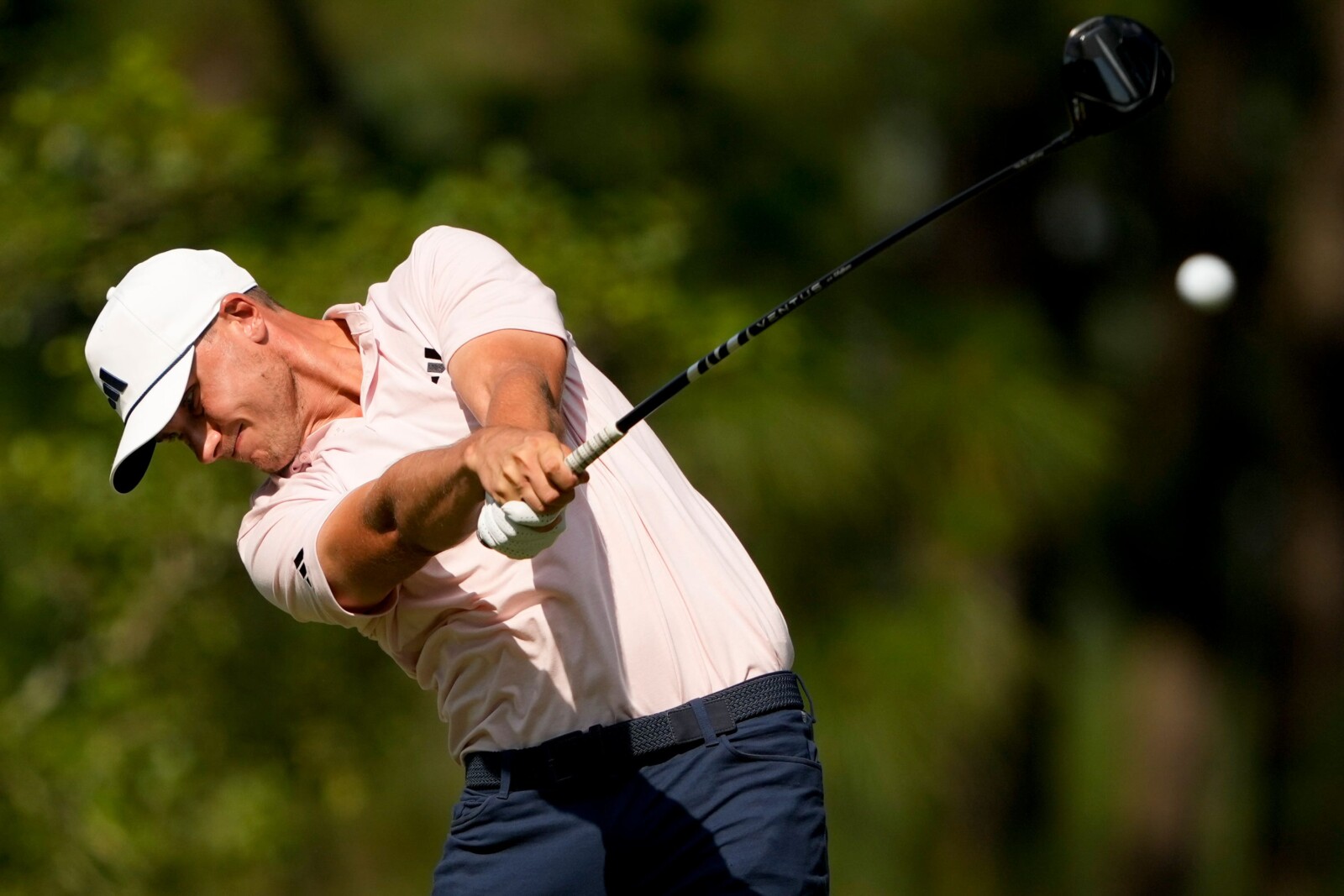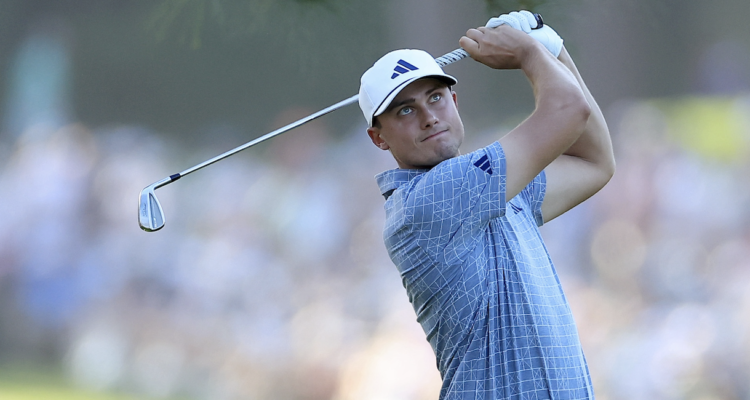After winning on the PGA Tour and DP World Tour just a few months after turning professional and playing a starring role in Europe’s Ryder Cup victory in Rome, LUDVIG ABERG is already pulling up trees on the major stage, with the 24-year-old Swede looking destined to become the game’s next global superstar. Not that this coolest of customers getting carried away with the hype….
Although you enjoyed a very successful amateur and college career, have you been surprised by how quickly you’ve found success in the professional game?
I wouldn’t say surprised. I know what my qualities are, but I think what I’ve been surprised by is how quickly those have shown up at this level, as it’s obviously a massive step up from where I came from, playing college golf in the US.
It’s same club, the same ball – all those things – but I feel like I’ve managed to handle all of the off-course demands quite well, which has helped me to keep my focus on the golf course.
The biggest difference for me playing college golf versus professional is just the sheer amount of golf you play. Even though we played quite a busy schedule in college, it’s nothing like what we do on tour, where you travel a lot, you play four or five weeks in a row and – it’s just a lot more golf.
But it’s something that I like and enjoy. Even when I’m practicing, I prefer to play golf rather than hit balls on the range, as it tests your ability to score rather than simply working on the mechanics of the swing.
You were thrown into the deep end at the Ryder Cup in Rome. What were your key takeaways from that experience?
The Ryder Cup was a huge learning curve for me. I’d be lying if I said it wasn’t intimidating and incredibly nerve-wracking going there as a rookie, but I got to spend time with some of the best players in the world, so I just tried to soak it all up – listen to the guys, talk to them and try to learn all I could from them. To be in that team, in the team room, and playing and spending time with those guys gave me a real boost to my confidence and definitely helped me to then be able to play good golf for the rest of the year.
You’ve obviously had such a meteoric rise to where you are right now. Did you feel the weight of expectations at all starting out this year?
I think there are always going to be expectations. It’s kind of what you sign up for in professional sport. I do understand that it is a part of it, but I’m always going to have a lot of expectations on myself as well. I know what I want to achieve, so if I don’t live up to that I’m going to be the first to call myself out on it.
There’s nothing that I can do about all the outside noise, and whatever expectations other people put on me. All I can try to do is play each tournament the best I can and see where that takes me.
Starting out the year I sat down with my team and I was looking at the schedule and seeing all these incredible events I was going to get to play in, and that was very exciting. It was just one great tournament after another. Bay Hill, The Players, Pebble Beach, the Genesis, all the Majors, the list goes on.

You finished runner up to Scottie Scheffler in your major championship debut at the Masters. What were you most proud of in your performance that week?
I had played Augusta as a freshman in college back in 2019, so I was not completely unfamiliar with the course, but the whole atmosphere around the Masters is on a different scale, so I was pretty nervous coming into the week and I was definitely shaking a little bit on the first tee!
My caddie, Joe [Skovron], knows Augusta like the back of his hand, so that was a huge help in knowing where to hit it and where not to go, but just playing there was such a privilege, and I’m super proud of myself in the way I handled it and especially to be in contention going into the back nine on Sunday.
Hitting it in the water at the 11th hole wasn’t ideal, as that lost me a lot of momentum, but I’m proud of the way I stuck in there. Among the many things I took away from Augusta is that it’s very difficult to force things and to instantly make up for your mistakes. Most of the time you just have to take your medicine and be okay with that. But I felt like that was one of the things I did well was to stay disciplined, stay on the right side of the pins, and keep giving myself chances.
That discipline looked to stand you in good stead at the US Open, where you became the first rookie to hold the 36-hole lead. How did you feel about the week at Pinehurst?
It was a great experience. Pinehurst was obviously very difficult, but I felt like I handled it pretty well. It was tough. I played in the US Amateur there a couple of years ago, so I kind of knew a little bit of what to expect in terms of the demands of the course. It was super tricky and asked a lot of questions in terms of approach shot trajectories, height and spin, but also in terms of staying patient.
I had some freaky things happen, which cost me a lot of shots, but other than that, I felt like it was a good experience and one that I will learn from and take forward with me. Tournament golf doesn’t really get much harder than that, so I now know what’s needed to perform at this level under those kinds of conditions. It may not have looked like it at times, but I really enjoyed the challenge.

You seem to be able stay in control of your emotions even when things aren’t going so well. Is that just the kind of person you are?
I’m not an angry person. I get more frustrated and disappointed with myself. I don’t toss clubs. I don’t throw tantrums. I get frustrated with myself if I can’t figure something out, and that sometimes holds me back a little bit, but I’m working on it.
You’re not always going to play perfect golf, so all I try to do is keep my emotions intact – keeping my highs not too high and my lows not too low. It doesn’t work for everybody, but that’s how I see it.
How do you feel about your chances at The Open Championship at Troon. Do you have any early thoughts about the course?
I don’t know what it looks like, to be honest. We’re going go the week before the Scottish Open to play it, just to get a little bit of a scouting trip. We’ve done that for Augusta and Pinehurst as well. I think it’s a good way to do it, just to get the feel of the ground and not be in that major environment. Obviously, you’re going to have to be prepared for anything in terms of the weather in terms of wind, rain, cold, hot, sunny, etc. We don’t really know what to expect, so just be prepared for anything and make sure we’re ready.
How excited are you to be representing Sweden at the Summer Olympics in Paris?
Obviously there is a tremendous amount of pride that comes from representing your country and representing all the people back home. It’ll be a very cool experience.
Ever since I watched Henrik Stenson and David Lingmerth play in 2016 in Brazil, I wanted to be a part of it. I was in high school at the time, but it was an awesome experience to watch those guys.
I’ve represented Sweden at amateur level and it’s a privilege to represent your country and wear the blue and yellow colours on my bag and on my clothes, soI think we’ll have a lot of cool memories for a long time.
THE ABERG FILES
BORN: Eslöv, Sweden
LIVES: Tallahasee, Florida
AGE: 24
TURNED PRO: 2023
WORLD RANKING: 4
PRO APPEARANCES: 34 (29 PGA Tour, 5 DP World Tour)
CUTS MADE: 28
WINS: 2 (2023 RBC Classic, 2023 Omega European Masters)
TOP 10s: 10 PGA Tour, 4 DP World Tour
PRIZE MONEY: PGA Tour $10.83m, DP World Tour €639,662
RYDER CUP APPEARANCES: 1 (2023)
PGA TOUR PERFORMANCE STATS
DRIVING AVERAGE: 308 yards (25th)
DRIVING ACCURACY: 69% (16)
GREENS IN REGULATION: 68% (23)
PROXIMTY TO HOLE: 35ft (6)
PUTT AVERAGE: 1.75 (63)
AVERAGE SCORE: 69.67 (12)
WHAT’S IN LUDVIG’S BAG?
Driver: Titleist TSR2 (9°)
Fairway woods: TaylorMade Stealth 2 (3 (15°), 5 (18°), 7 (21°)
Irons: Titleist T-100 (4-9)
Wedges: Titleist Vokey Design SM10 (50°, 54°) Titleist Vokey WedgeWorks Proto (60°)
Putter: Odyssey Works Versa #1
Ball: Titleist Pro V1x



